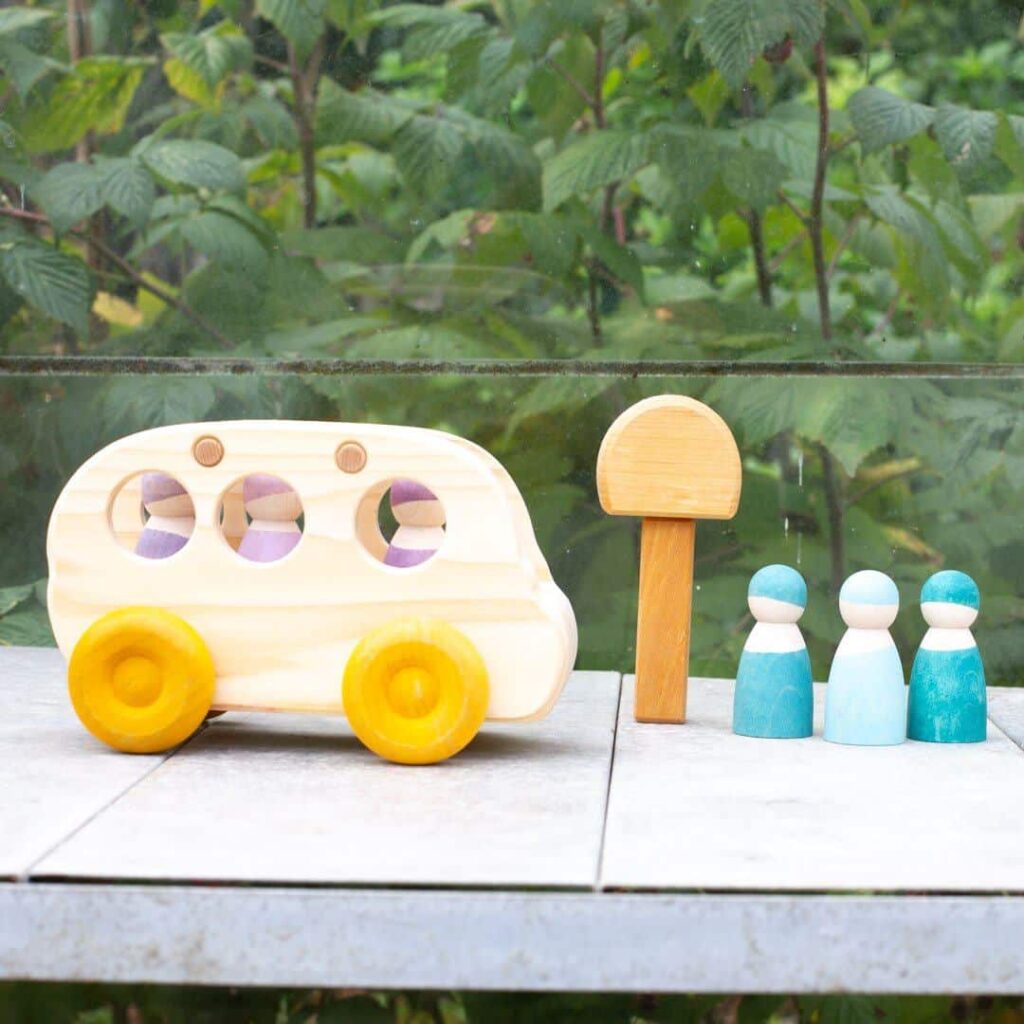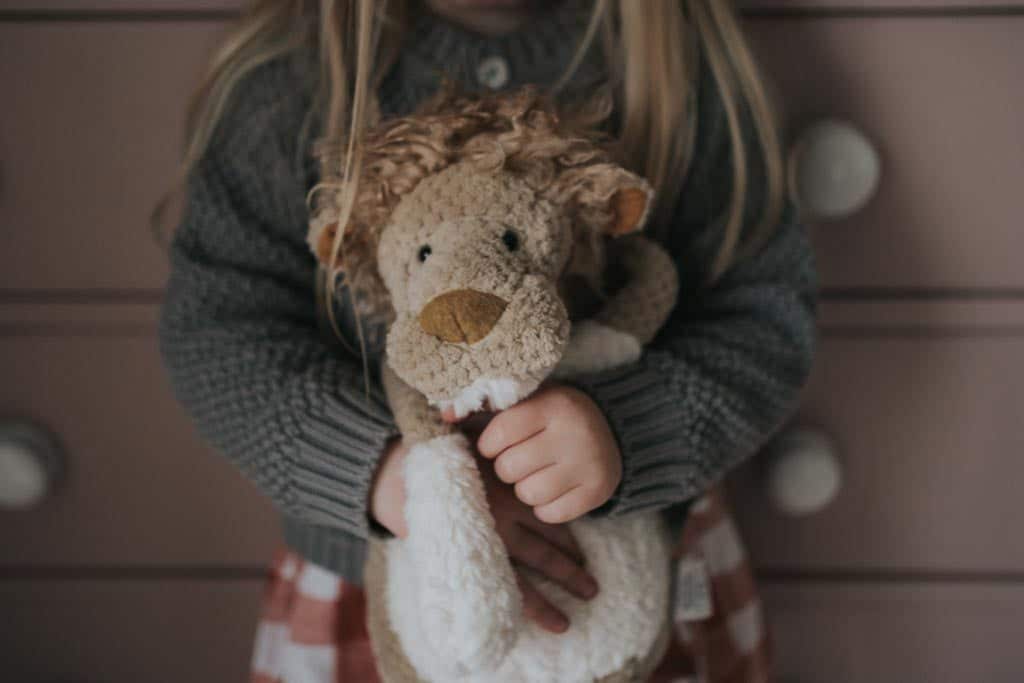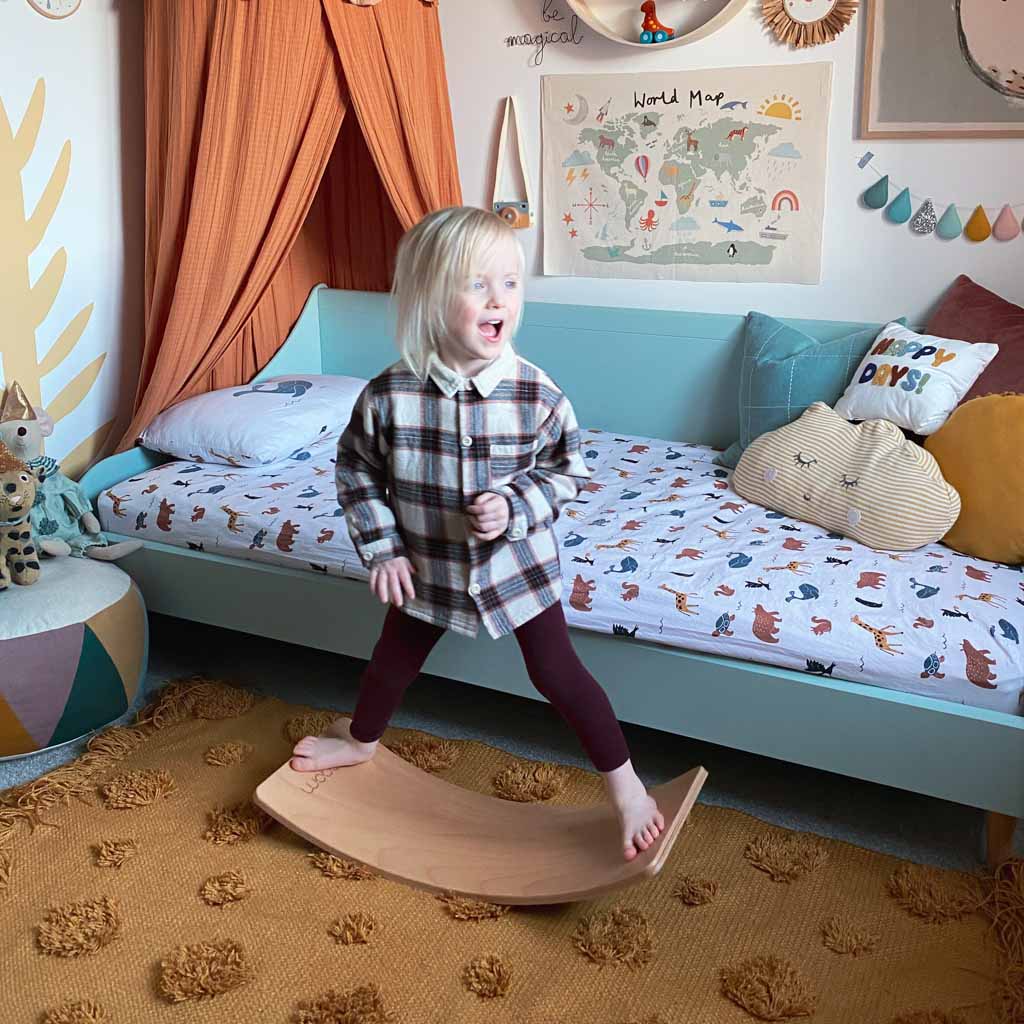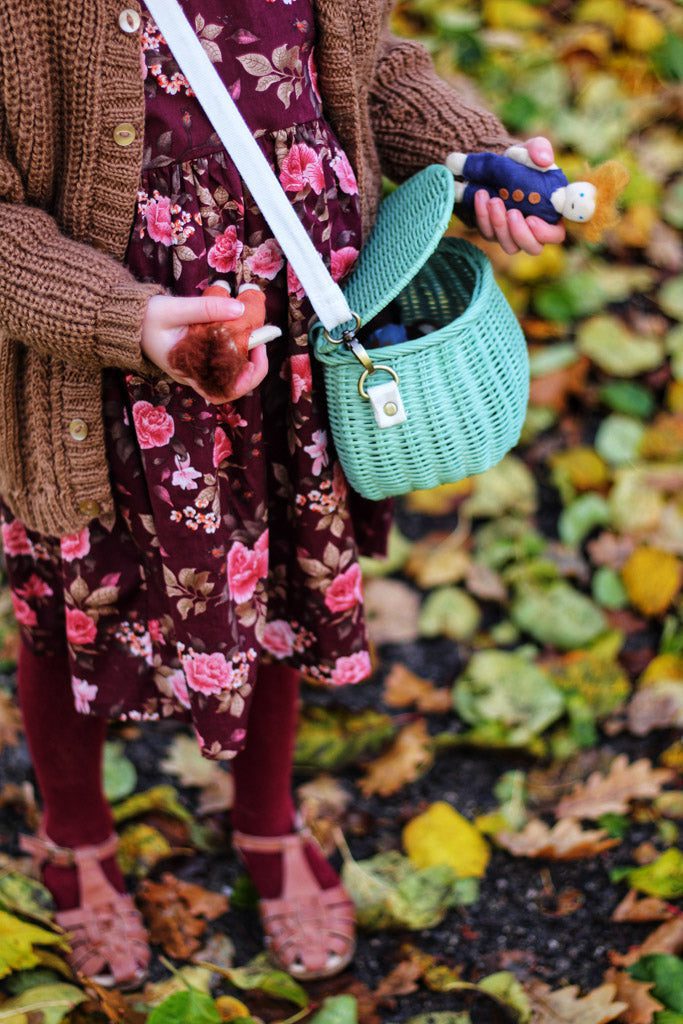Grimm’s toys are easy to love. The beautiful colours, the natural feel, the endless play possibilities. But where to start? If you’re planning your first purchase, it can be hard to decide.
Much depends on what’s already in your toy box. A set of blocks is essential, and you’ll need some figures. Beyond that, you can be sure that all of the following will make great additions to your collection.
One of the nicest things about Grimm’s toys is that they work just as well for toddlers as they do for five-year-olds, but if you’re looking for a little more guidance, we do give age recommendations at the end of this post. If you can’t wait, here’s our list of the best Grimm’s toys.
- Rainbows
- Blocks
- Rainbow Friends
- Cars, buses and trains
- Conical towers
- Building boards
- Nested bowls and boxes
Rainbows
Grimm’s rainbows are easy to love.
Combining both beauty and strength, the Grimm’s Rainbow is also extremely versatile. It can be stacked or stretched out into a tunnel, and naturally lends itself to teaching early mathematical concepts.
Read our Grimm’s Rainbow review
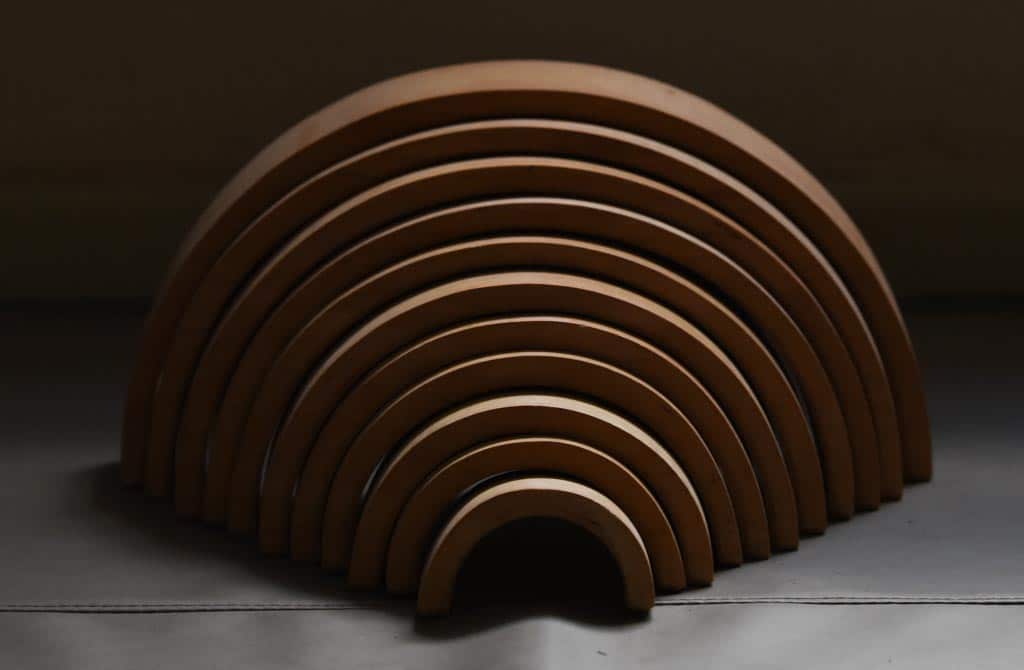
Blocks
Nothing beats blocks. There isn’t a more versatile or durable toy, and there are countless varieties to choose from. Grimm’s are famous for their rainbow colours, but blocks with a natural finish have their place in any toy box. It’s easy to become distracted by the beauty of coloured blocks and to think that they are the main event (which they can sometimes be). But often they simply set the scene for small world play, and it’s here that the qualities of naturally-finished blocks come into focus. They offer a distraction-free canvas for your creations, as well as being beautiful in their own right. To learn more about how to get the most out of block play and help choosing the best set, see our Guide to Blocks.

Natural Geo Blocks soften the strong lines of the Giant Building Blocks and help bring the scene to life. Can you imagine how confusing this mountain would be if made from brightly-coloured pieces?

‘Trees’ from the Mixed Forest, Baby Bear’s woodland home.

The natural finish of the blocks works well with pastel colours.

The Grimm’s Pastel Cube is a brilliant first set. Blocks of 4cm x 4cm are perfect for little hands to manipulate and stack. If you’re thinking of buying for a child between six and eighteen months, this is the one to get. You might be tempted to go for the smaller pieces found in the Geo Blocks set but a smaller surface area makes them harder to place and balance.
Rainbow friends
Alongside the 12-piece rainbow, these are the iconic Grimm’s toy. A simple, classic shape, these peg people are easy for small hands to hold and their expressionless faces are somehow friendly and serene. Even older children, used to playing with more sophisticated figures, are nevertheless happy to include them in their games.
So much of babies’ and toddlers’ play is about placing, positioning and posting. You’ll find that your rainbow friends spend more time being dropped into holes and carried in baskets than used in small world play. It’s one of the reasons they are such a versatile and well-loved toy.

Each friend is individually dipped in dye, giving it a unique hat and neckline.
Cars, buses and trains
For many children, toddlerdom begins a love affair with vehicles that lasts for many years. But what’s the attraction? Especially before three years of age, children’s play is often dominated by the ‘schemas’ they are interested in. A schema is a repeated pattern of movement that a child makes in order to better understand a phenomenon. So, for example, a child investigating the rotation schema will be obsessed with all things that spin. They’ll watch the washing machine go round, enjoy holding a pinwheel and delight in spinning around on the grass until they fall over.
Schemas of interest to vehicle lovers are trajectory (the direction the vehicle takes), transportation (if it has the capacity to carry things), rotation (the wheels), enveloping (driving through tunnels) and positioning (lining vehicles up). You can read about these schemas in more depth here. But suffice to say, vehicles press a lot of buttons for a two-year-old.
Don’t buy a Grimm’s car for a toddler and expect it to stay pristine, however. Grimm’s use unvarnished wood and vehicles launched from tables or driven into walls will eventually develop scuff marks. Fortunately, this lends cars a certain battle-hardened character and they are otherwise incredibly robust. They also roll very smoothly, which makes them satisfying to play with. You certainly won’t bend the axle by pressing down on them, which is often the case with cheap, die-cast cars. If you take a look at the red truck below, you’ll see the kinds of marks that are typical – a couple of dark lines on the bumper from crashes, and some lighter ones on top. Barely noticeable, but something to consider if you were hoping to keep them immaculate.

Add some figures and turn vehicle play into a story.

A pickup truck is a dream for anyone exploring their transportation schema.

If there’s too much colour in your Grimm’s collection, tone it down with a set of black cars.
Conical towers
The stacking tower is the quintessential toy for children under one, and for good reason. This is the age of picking up and putting down, positioning and repositioning. It’s the time when gross motor movements, such as using the whole arm, are starting to be co-ordinated with fine motor movements, for example isolating fingers.
Young babies have very little control over their movements. Much of what they do is pure reflex. Put your finger in the palm of their hand and the hand closes over it. A few months later, they are able to open and close the hand at will, pick things up and drop them again – not always easy at first!
There’s a lot of skill required to successfully stack a ring on the post, and it may be another year before the rings go on in order.
When choosing a tower, you must decide between two main types: flat or rounded base. Those with a flat base are stable and easy to stack, but they are much more dangerous if fallen on (an important consideration when there are wobbly toddlers in the room). The round-bottomed towers are safer but trickier to stack. If you’re going to keep it on the floor, go for a wobbly one. The flat-based towers are great on a low child’s table.
For complete peace of mind, the pieces can be stacked without using the post at all, by simply putting one one top of another.

Flat-bottomed or wobbly, which do you prefer?

Towers aren’t just for stacking. Get creative and see what else you can use them for. Turned on their side, they’ll also roll beautifully.
Building boards
The item that we felt was always missing from the Grimm’s collection has finally arrived: building boards. We love Grimm’s building blocks but they have one great limitation: their length. There are very few blocks long enough to create the kind of span required for a bridge or a really big doorway. With the building boards, that problem has now been solved. They also make great ramps for marbles and vehicles.

Increase the scale of your constructions with building boards.
Nested bowls and boxes
Nested toys are a simple introduction to early maths.
Babies learn that some objects fit into holes but not others. They are developing an understanding of big and small. Next comes the need to put three objects in order: small, medium and large; big, bigger, biggest. Think the Three Bears’ porridge bowls or chairs.
Nested toys are brilliant because they teach seriation, the idea that you can organise objects according to characteristics such as height or length. Rather than small, medium and large, you can learn to order ten or even twelve items (if you’re using a rainbow). They are what’s known as a ‘didactic’ material. This means that they teach you without the need for an adult. You learn the concept simply by playing with the toy.
Once you know that stacking toys must be completed in a set order, it’s much easier to understand that numbers work in the same way. 1, 2, 3, 4, 5… The order never changes.
Grimm’s range of nested toys is extensive, and they’re all very beautiful. From rainbows to bowls, boxes to waves, you have a great number of styles and colours to choose from.

Nested boxes have many uses. After they’ve outgrown their usefulness as aids to teach seriation, they can be repurposed to serve as building blocks or even storage.

Nested boxes make a cosy home for these penguins…

…or a garage for cars.

Upturned nested bowls make elegant towers. Look out for some beautiful wood grain if you choose a natural finish.

Grimm’s waterwaves

Here you can see the outer arches of the Sunset Rainbow alongside pieces from the waterwaves set.
Conclusion
The best thing about Grimm’s toys is their versatility. You’ll find that many enjoy a second life once they have outlived their initial purpose, often finding their way into your basket of blocks and incorporated into small world play.
Here are some brief recommendations by age. They’re not set in stone as most Grimm’s toys are suitable for the whole age range. Just bear in mind that younger children may have trouble manipulating the largest pieces and assembling complicated nested toys like the Waterwaves will be impossible.
6 – 12 months: 36 cubes, nested bowls, rainbow friends, bus
1 – 3 years: 6-piece rainbows, geo blocks, cars and trucks, Rainbow Friends
˜
˜
3 – 5 years: larger sets of blocks, nested toys, boards and semicircles.

